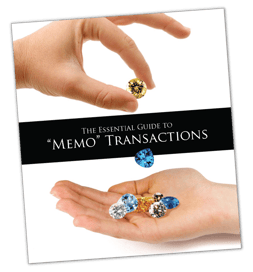
How to Protect Your Merchandise Using “The Essential Guide to Memo Transactions”

Memo…consignment…whatever you call it, selling on memo offers great benefits for both suppliers and merchandisers. Suppliers can place their goods in desirable stores, while merchandisers can experiment with new lines without any financial commitment. However, it does come with risks, such as potential loss of goods if a merchandiser goes bankrupt. Be sure to check out our first blog post on the topic of safely Selling on Memo.
This blog post expands on that post with an overview of how to conduct business on memo and safeguard your assets. It is derived from “The Essential Guide to Memo Transactions,” a comprehensive resource JBT developed in collaboration with the Jewelers Vigilance Committee. Download your free copy of the full guide here.
Assess the Consignor’s Financial Profile
Before signing a consignment agreement, assess the company's financial health to determine your credit risk and its alignment with your company's risk tolerance. Data-based decisions at the onset help prevent difficult liabilities in the future.
JBT serves as a valuable resource here. We offer members access to information to make independent credit assessments of potential consignors, including credit reports, the company's website, and Uniform Commercial Code (UCC) documentation that specifies which company assets are collateral for any outstanding debts. We also provide the necessary Security and Exchange Commission (SEC) forms consignors are required to complete, promoting transparency, fair dealings, and the disclosure of crucial market information.
Create a Secured Transaction with a UCC
The UCC code is clear: while the consignee has your merchandise they have the same rights and title to the goods as you do, enabling them to use the goods as collateral on a loan.
Suppliers can safeguard themselves in case of a consignee’s bankruptcy by completing these 3 documents before shipping merchandise on memo:
- A consignment agreement signed by the merchant
- A copy of a properly-filed UCC-1
- A copy of the notice the supplier sent to the merchant’s other creditors holding perfected liens on inventory.
Once these documents are filed, a security interest in the goods is established, provided the memo transaction meets all necessary criteria. That means that in the event of a consignee’s bankruptcy, the debt owed to the supplier takes precedence over other debts.
Create a Consignment Deal
Creating and perfecting a security interest requires meticulous attention to detail and a sound understanding of the law. Before shipping your merchandise to a consignee, consult with an attorney or use a UCC filing service to ensure your merchandise is adequately protected. Here are the initial steps you should take when creating a consignment:
- The first step involves crafting a memo agreement, which is equivalent to a security agreement because it establishes a loan.
- The second step entails correctly filing a UCC-1, notifying lenders that the merchandise is not the property of the consignee.
- The third step involves identifying if another lender has already secured and perfected an interest in the consignee's inventory. You are responsible for informing any existing lender of your priority interest in the memo merchandise.
Become Versed in the Importance of Follow-ups and Expirations
After filing the UCC-1 and delivering the consigned merchandise, these steps will minimize risk and ensure the security of your merchandise during its time on memo:
- After submitting the UCC-1, perform a search to verify that the form has been filed.
- Every quarter, check if the consignee has changed their business structure. If they have changed their location, business name, or business finances that may invalidate your UCC-1 agreement, so you must file a new form or amendment against the consignee.
- Every five years, you must file a new UCC-1 and create a new notice to existing lenders to protect your merchandise.
- Regularly check the creditworthiness of the consignee by monitoring their credit reports and SEC filings. You should also monitor the status of the consignee’s other secured lenders, such as banks.
For simplicity, JBT Members can place their consignees on a CreditWatch list. If the consignee experiences a worsening of credit conditions or a change of ownership or location, the Member is automatically alerted so they can take the necessary action.
Understand How Bankruptcy Impacts Memo Transactions
An important bankruptcy law you should know about is the 90-day preferential transfer rule. If you have been paid or the merchandise has been transferred to you within 90 days of the consignee declaring bankruptcy, the transfer may be reversed by the bankruptcy court, and the courts then claim the merchandise.
 To learn more about memo transactions and get your questions answered, download “The Essential Guide to “Memo” Transactions” by the Jewelers Vigilance Committee.
To learn more about memo transactions and get your questions answered, download “The Essential Guide to “Memo” Transactions” by the Jewelers Vigilance Committee.
Become a JBT member today! Membership includes online UCC-1 filing services and resources to stay informed about your Jewelry Business partners. Discover how we can help you make informed business decisions.

